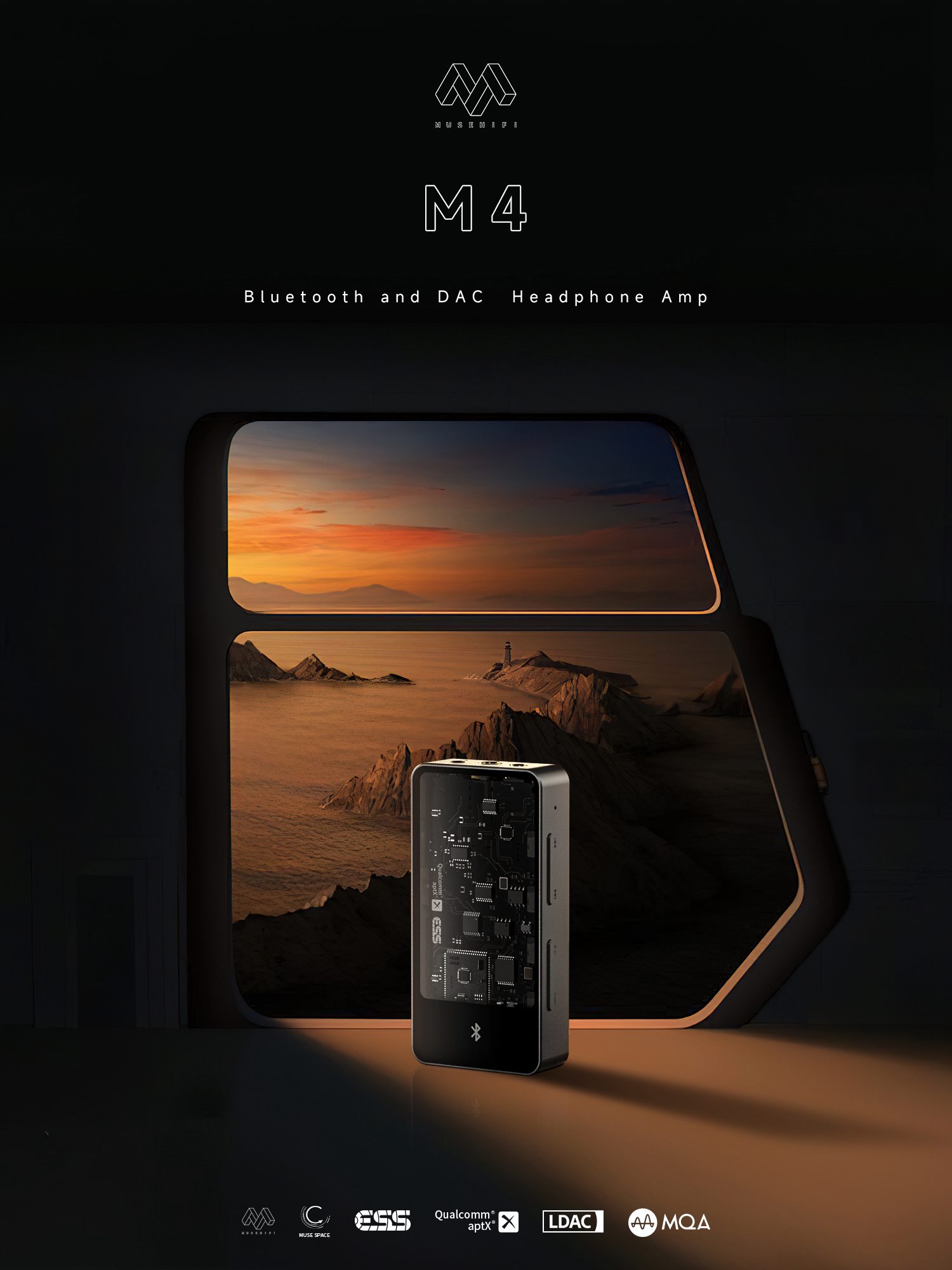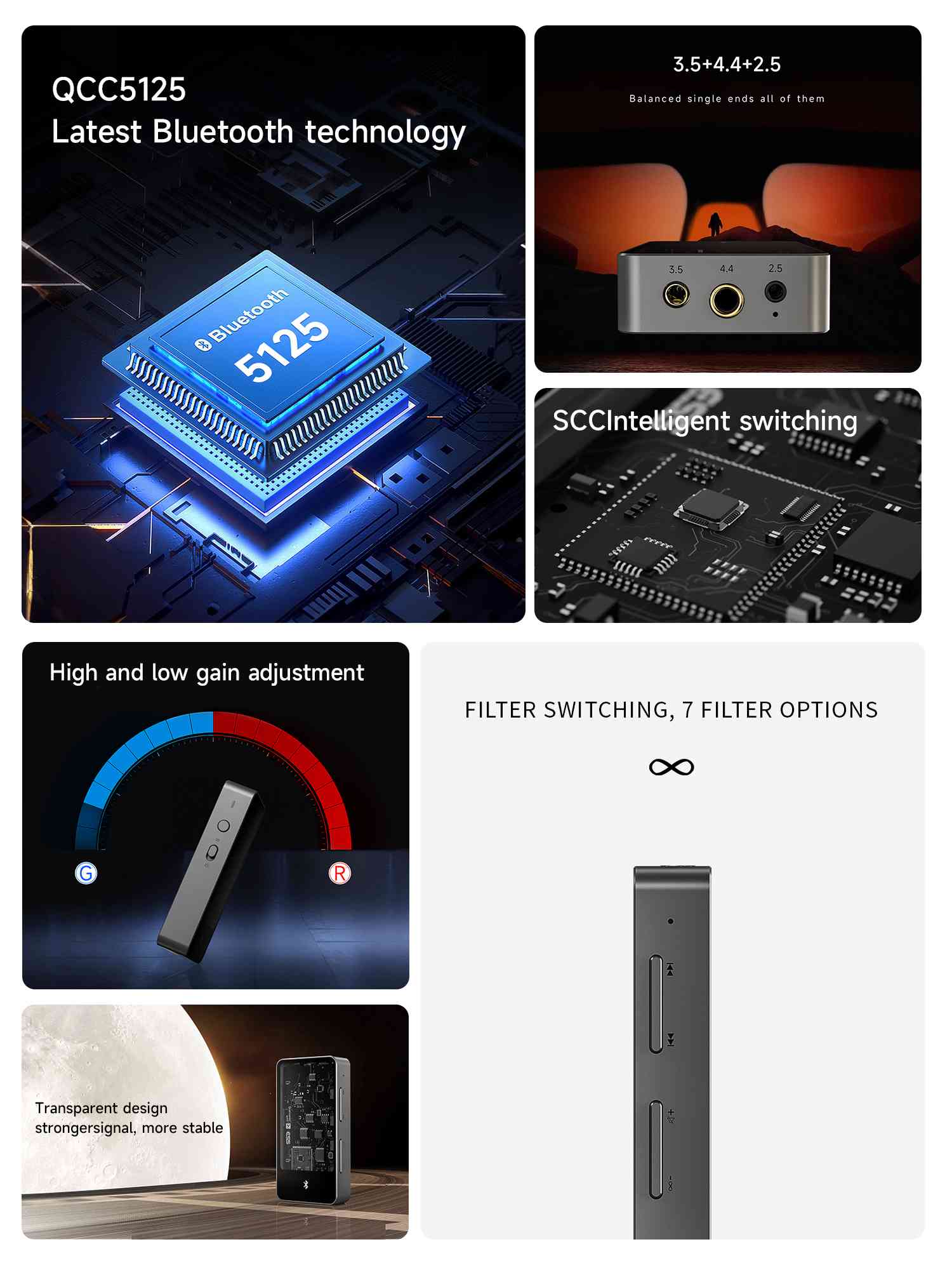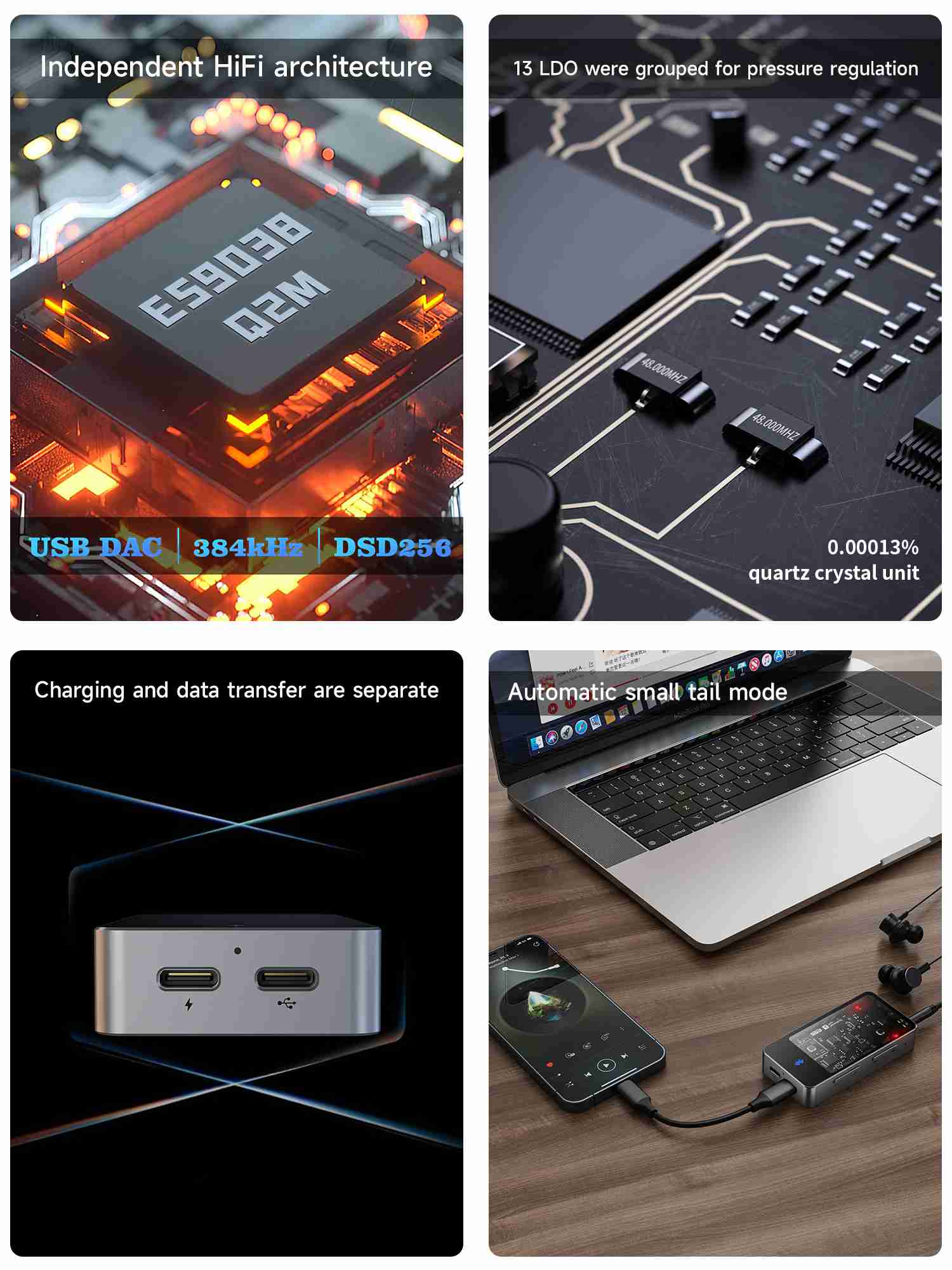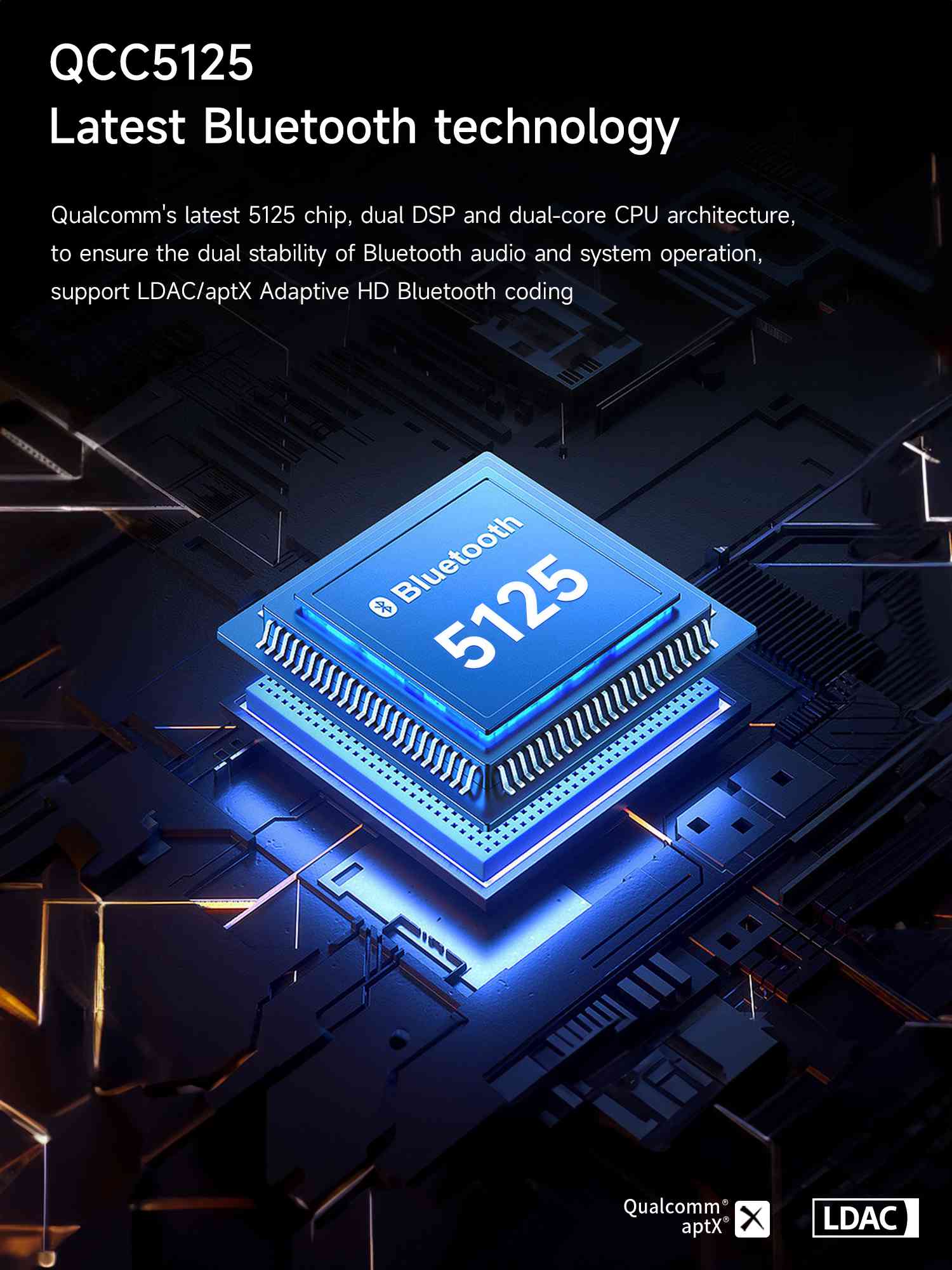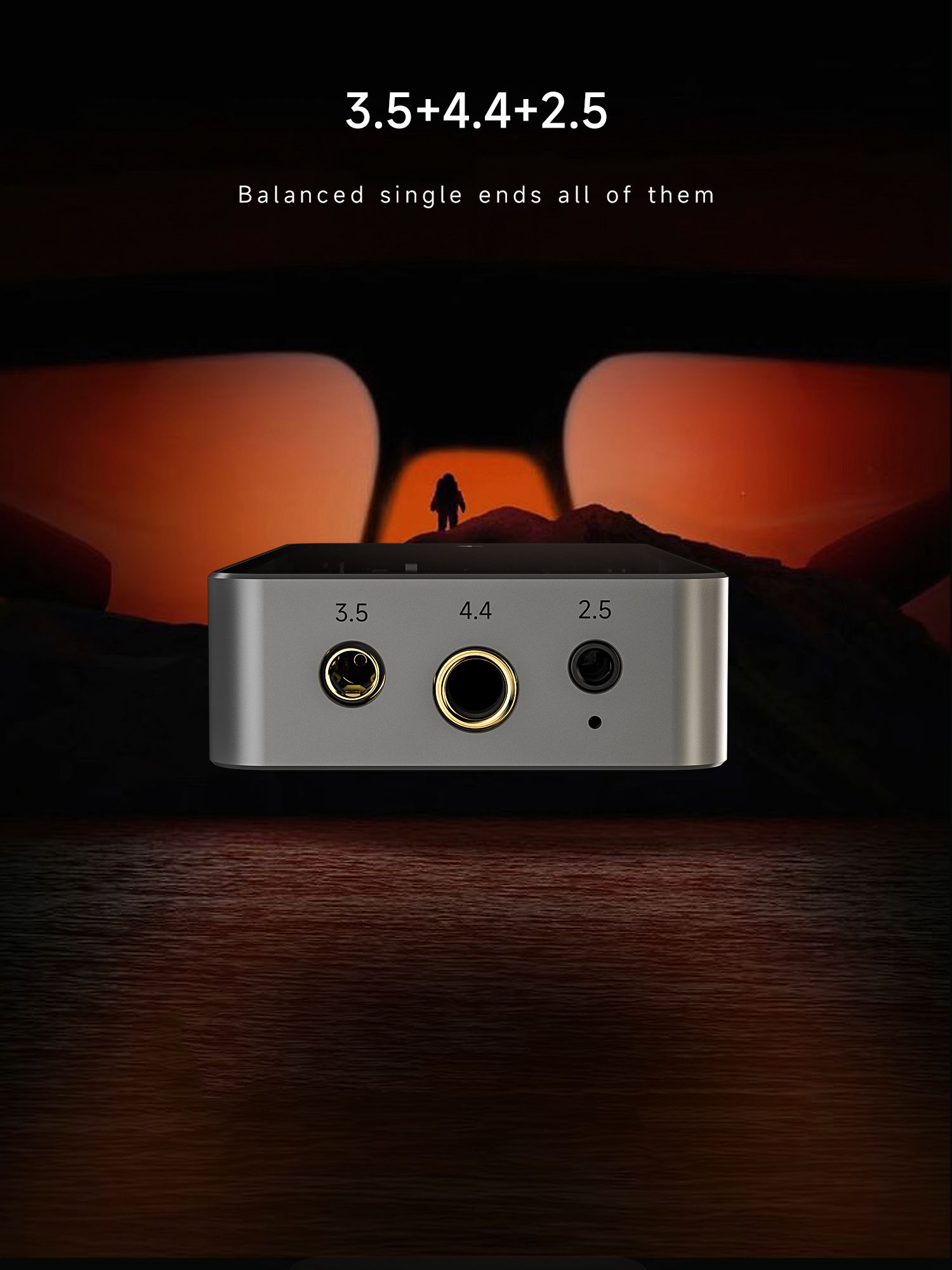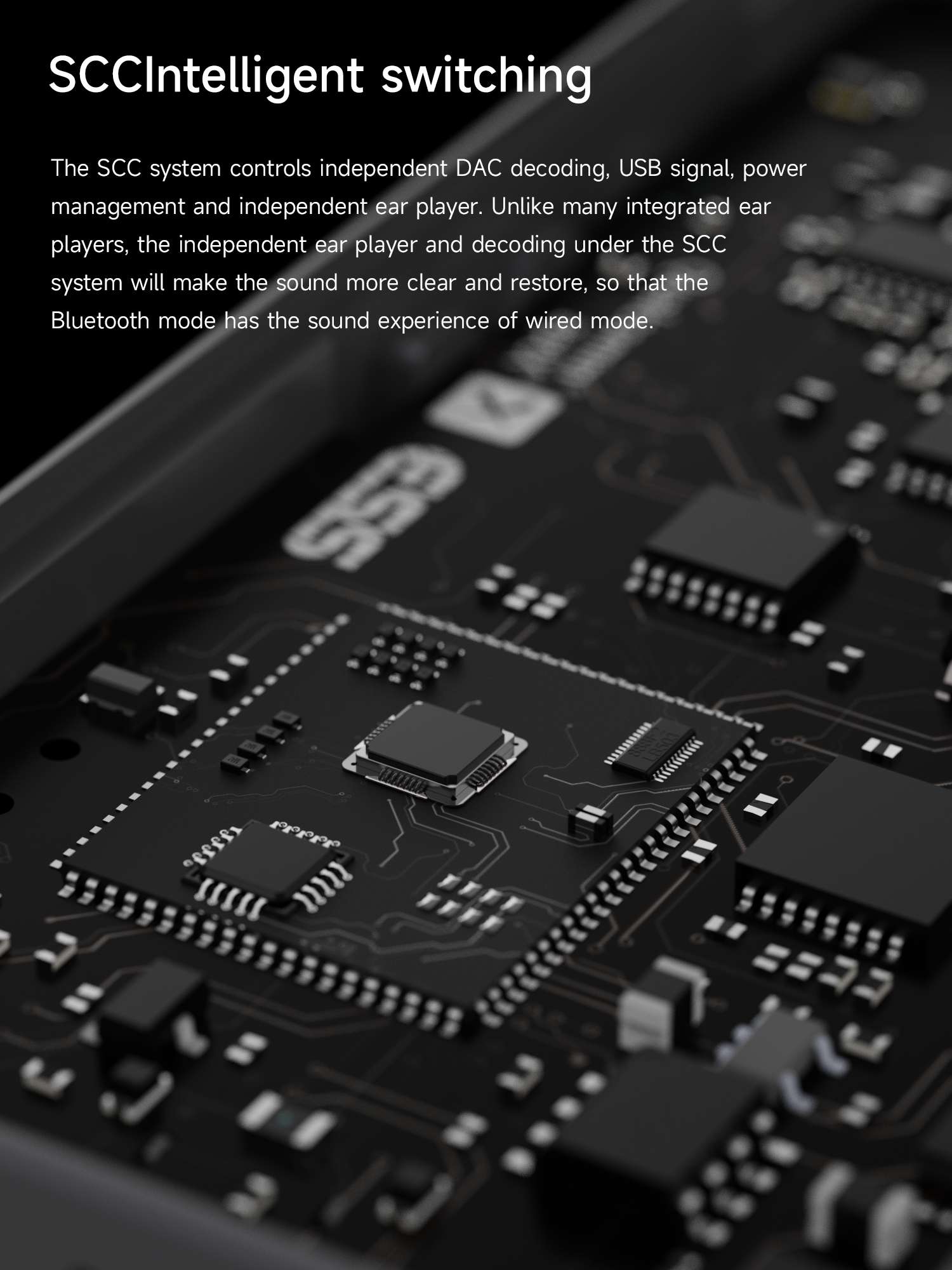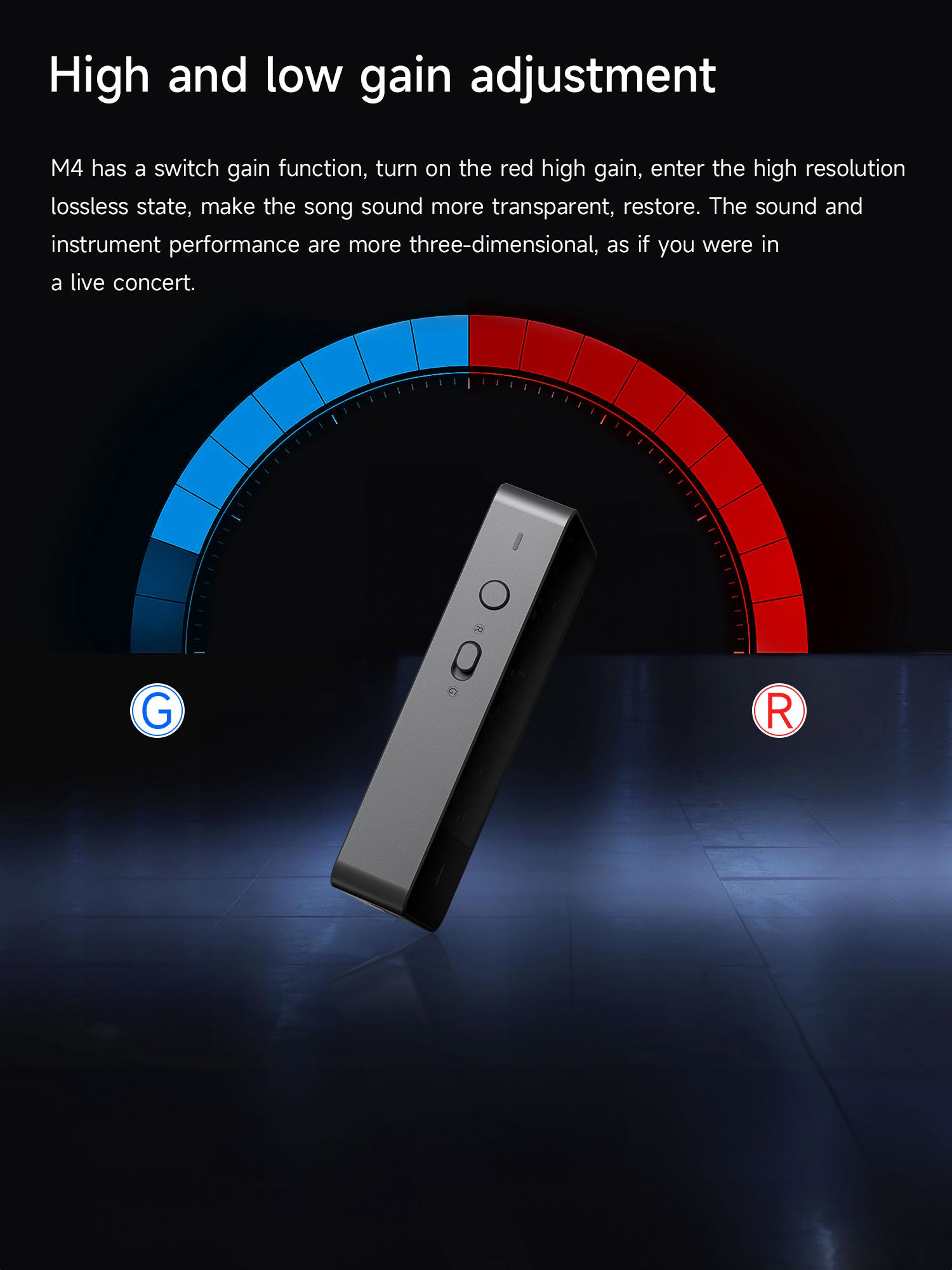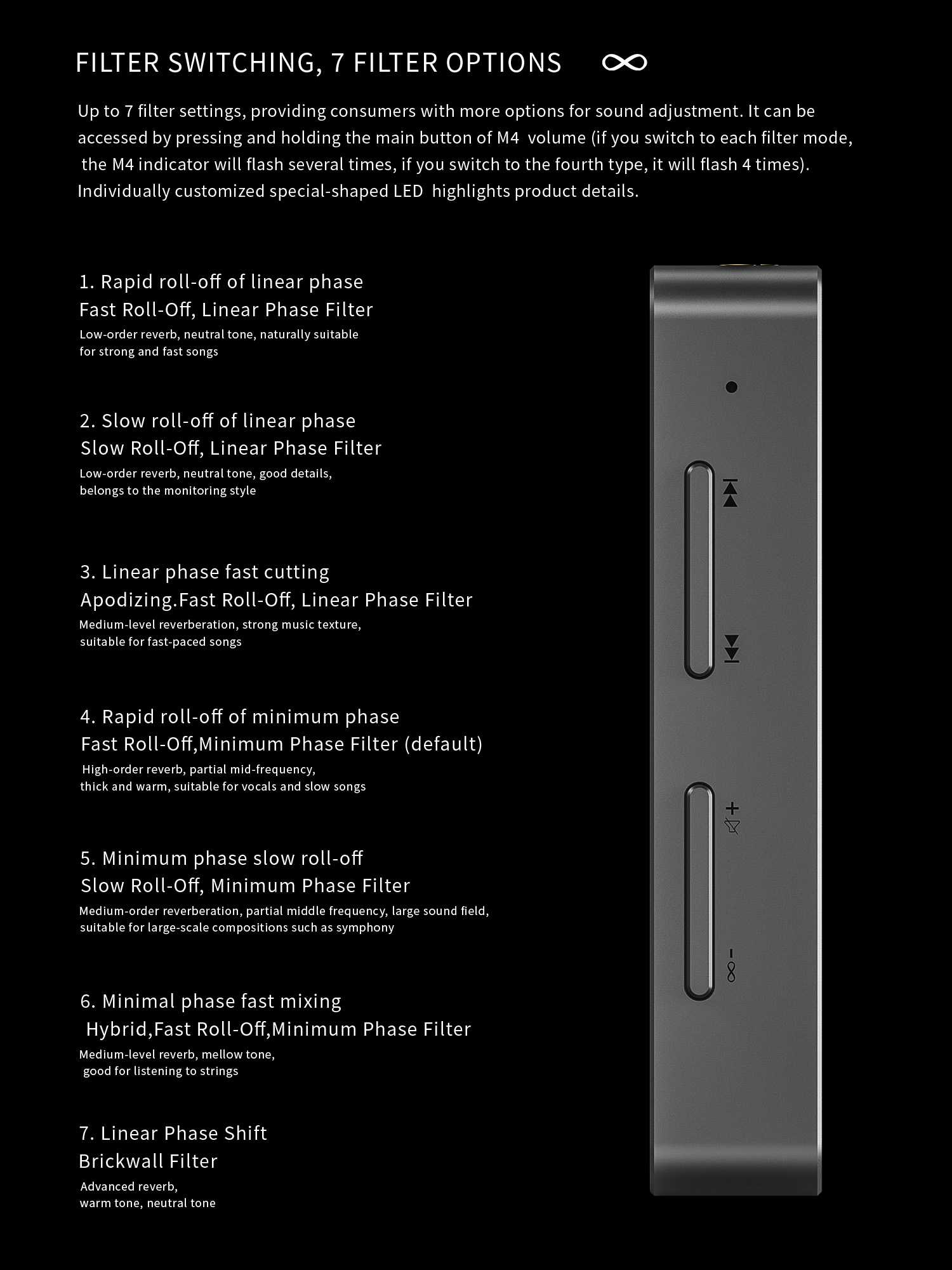Disclaimer:
The
Muse Hifi M4 was sent to me as a review sample from
HIFIGO, for which I thank them!
I’m very grateful to have the opportunity to collaborate with this store. I must admit that they are another important contributor to my hobby. Without them, I wouldn’t be able to have all these opportunities to try out so many IEMS and DACs.
The review, as always, will be completely unbiased and uninfluenced.
I would like to remind you that I am just a person who enjoys trying out new audio products and listening to a lot of music. I am not an expert; this isn’t my work but just my hobby.
My opinions are obviously subjective.
Tech Specs:
- Bluetooth version: Bluetooth 5.1
- Volume adjustment: The volume of the phone can be adjusted separately
- and independently
- Compatibility: AAC/SBC/aptX/aptX LL/aptX Adaptive/aptX
- HD/LDACBluetooth chip: QCC5125
- Independent chip: ES9038Q2M
- Independent amp: ES9603Q
- USB DAC: SA9137
- Independent play pause button: Yes
- Independent volume key: Yes
- Independent song before and after adjustment: Yes
- Transmission distance: 12M
- Gain setting: L/H
- Volume level: 60
- Output power: 3.5>160mW + 160mW; 2.5/4.4 > 320mW + 320mW(32Ω) SNR:3.5>118dB:25/4.4>115dB(A)
- Noise: 3.5 <3uV: 2.5/4.4 <5.5uV
- THD+N:3.5<0.00048%:25/4.4<0.00032(1KHz/6-dB@32Ω)
- Separation degree: 3.5>75dB,2.5/44 107 db or higher
- Microphone: Support Bluetooth voice call, built-in omnidirectional microphone, support CTIA headset wire control itself microphone
- NFC: Supported
- No-drive mode: Supported
- Mobile decoding: Supported
- In-car mode: Supported
- MQA Render: Supported
- Plug type: 3.5mm+4.4mm+2.5mm
- USB interface: Type-C USB 2.0 (charging) + Type-C USB 2.0 (data transfer)
- Battery capacity: 1100mAh
- Endurance: 3.5mm>8h; 2.5/4.4mm 7h
- Size:41.8mm*84mm*15mm
- Weight:≈73g
- Accessory: Type-C USB
- Color: Silver
Optional accessories:
- 1. Type-C to Lighting
- 2. Type C to Type-C
- 3. USB plug
- 4. Real leather case
Packaging:
The Muse Hifi M4 arrives in a discreetly well-finished and sturdy black box.
A USB-to-Type C cable and an instruction manual are found inside a separate box right away. Honestly, I would have also expected a Type C to Type C cable, but it doesn’t matter. I have many at home.
Finally, we find the Muse Hifi M4, nestled in the plastic. I must admit that the accessories included in the package are a bit limited in quantity. However, they can be purchased separately.
Build quality / First impressions:
The design immediately reminded me of the Kmerj KM01 DAC. I really like transparent things; seeing the motherboard and the chips always has a certain charm. Here, my macro photos will probably make you better understand the beauty of the Muse Hifi M4 and also the construction quality.
The front and back appear to be tempered glass; they are cold to the touch, so I think they are glass. Along with the buttons and gain switch, there are three small holes around the aluminum frame. One of these is for the LED that indicates the charging status, and the other two are supposed to be for the omnidirectional microphones.
I have to admit that the key feedback is also very good. In the upper part, you can see that we have all the necessary outputs: 3.5mm, 4.4mm, and 2.5mm. Below we find two Type C ports, one dedicated to charging and the other to data, as it can be recharged while in use or used as a wired DAC. It’s such a versatile device that you’re spoiled for choice.
On the accessories side, we only have a good-quality cable included. As I said before, I would have had some more accessories included.
Outputs Power:
Muse Hifi M4 has 3 outputs:
- 3.5mm 160+160mW 32OHM
- 4.4mm 320+320mW 32OHM
- 2.5mm 320+320mW 32OHM
The balanced connectors were initially very difficult to insert into their respective outputs; fortunately, by using them, the problem disappears.
In terms of power, I don’t think you will have any kind of problem with any IEMs.
The ES9038Q2M DAC chip is paired with the ES9603Q amp, which is the same pairing seen on the F.Audio KS01.
I tested the outputs with:
- Kefine Klanar planars on both 3.5mm and 2.5mm output with excellent results, but on the other hand, we are talking about a very efficient planar.
- Lethuer S12 Pro on 4.4mm output are slightly harder to drive than the Klanar, but only slightly.
- Kinera Celest Phoenixcall on 3.5mm and 4.4mm balanced without any efforts. There is enough power for it.
- Hidizs MP145 on 4.4mm output and is driven very well, like some desktop DACs.
- Hifiman He400Se on 4.4mm output on high gain definitely put the Muse Hifi M4 under stress. By raising the volume beyond human levels, the M4 Dongle raises the white flag, sending some distortion into the headphones. Which doesn’t happen using, for example, the EPZ TP30 and Hidizs S9 Pro Plus. With this, the Hifiman can be easily driven without worries, in my opinion. I don’t think anyone will do prolonged listening at insane volumes… except me.
Rockers and buttons:
The Muse Hifi M4 rockers that allow volume adjustment at first glance appear to be only one, but in reality both have a volume adjustment function. By keeping the rocker pressed for a long time, where we find the symbols to send the playlist forward or backward, it is possible to roughly adjust the volume.
Fast Volume and Next/previous
Precise Volume and Mute + Filters
Gain Switch
Led + Power/play/pause
While the one dedicated to volume/mute/filters allows you to precisely adjust the volume with a quick press via Bluetooth connected to the POCO M4 Pro, it does not influence the volume of the smartphone, so it is as if I had three possibilities to correct the volume. There are an infinite number of volume combinations.
Obviously, the volume rocker also allows you to mute and change the filters. On the other side, we find the switch for the gain, low-gain blue lights, and high-gain red lights.
Audio Codecs:
The Muse Hifi M4 is equipped with the latest Qualcomm QCC5125 with dual DSP and dual-core CPU architecture, Using Bluetooth 5.1, the connection is super stable, and many codecs are available; in fact, we have AAC/SBC/aptX/aptX LL/aptX Adaptive/aptXHD/LDAC.
Wired Mode side led on
With all these formats, I don’t think you will have any problems. My POCO M4 Pro uses it in AAC or LDAC, so I did most of the testing with the best codec available. Keep in mind that if you use this codec, both the smartphone and the Bluetooth dongle will consume considerably more. In my test, you can reach up to 5 meters without problems. If you use codecs that require less important transmissions, then you can go much further.
Battery and energy management:
Muse Hifi M4 has very intelligent energy management. The 1100 mAh internal battery maintains autonomy expectations. In addition to being able to be connected via cable, it can be recharged and used at the same time. Below, we have two Type C ports, one dedicated to charging and the other to data. If you connect it wired to your phone, the Muse M4 will only use 20% of the phone’s power, and the rest will use its built-in battery.
High Gain LDAC + Red LED while charging
Fully Charged
With my iMac, I had no problem testing its charging and data functionality at the same time, but my smartphone didn’t want to accept any other cables other than its original one with a USB to Type C adapter. I’m literally full of cables to try; none of them work except for a very few. I am forced to recommend the original accessory in case you cannot find a suitable Type C cable. I only found one for a Jcally DAC, but it is so short as to be unusable even if it works with M4. Obviously, you don’t need an external power supply if you want to use it in wired mode, but a single cable in the data port.
In doubt that the issue was my smartphone, I took my old Redmi Note 7 mule, which I use as a player, but the exact same thing happened. OTG cables are needed, but not all of them are suitable.
Sound Signature:
I keep getting more and more DACs that use these chips, and currently this is the most neutral/reference-sounding one. The low ranges are not at all emphasized in any way. The mids seem quite natural, perhaps a little more recessed, while the highs are decidedly brighter. Taking the Hidizs S9 Pro Plus, for example, it is much warmer in sound than even the EPZ Tp30. In terms of resolution, I tested it with the LDAC connection, and the quality remains very high. With careful listening, everything seems slightly more compressed. Although the data flow is very massive, using LDAC, you will not notice any instability. There aren’t huge differences in quality with a wired DAC, but when you connect it via cable, I seem to hear the sound open up. Let’s say that even its very neutral tone makes it seem a little flat.
Digital Filters:
Surprisingly, we find the same filters present on the Hidizs S9 Pro Plus. LOL.
There isn’t an RGB LED to indicate which filter you’re on, but fortunately, the gain LEDs flash as many times as the filter you choose. For example, if we choose to try filter number 4, the gain LED will flash 4 times.
There are 7 filters that can be changed:
- Anodizing fast roll-off
- Linear phase fast roll-off
- Linear-phase slow roll-off
- Minimum phase fast roll-off
- Minimum phase slow roll-off
- Hybrid fast roll-off
- Linear Phase Shift Brickwall
I’m borrowing my opinion about filters from my own S9 Pro Plus review:
“The difference in filters is honestly very difficult to hear, especially if you are not used to paying critical attention to what you are hearing. If you think that switching from one filter to another will upset your life, know that you will be disappointed. The changes are extremely delicate and require almost bat-like ears. I sincerely admit to you my difficulty in hearing real changes, and therefore I would not recommend this DAC if your hope is to have 7 filters that completely change the sound.”
I honestly don’t know if, over time, I will be able to perceive even the faintest nuances of these filters.
Fast Comparison
vs Hiby W3 Saber
Some time ago, I purchased a Hiby W3 Saber for less than 50 USD. An AK4377 with dedicated amplification is concealed in a very light and compact device.
There is a decidedly well-made app for smartphones to manage the various functions it has. Obviously, it doesn’t have monstrous power, and above all, we have a single 3.5mm output. I have to say I’ve never had any problems using it in LDAC either. The only perhaps a little sore point is that we are the complete opposite of the Muse Hifi M4. The sound timbre of the W3 is extremely warm, so much so that it almost suggests a drop in resolution and detail. Obviously, it is a cheaper product.
vs EPZ TP30 or Hidizs S9 Pro Plus
I put them together because, since they are wired DACs, comparisons can be made in terms of power and tone. Personally, I remain a big fan of wired dongles; the TP30 and S9 Pro Plus have the same chip but different amplifications compared to the Muse M4. We have greater clarity under heavy load (for example, using the He400se) without loss of definition at full scale. Both have a warmer tone than the Muse implementation, which aimed for neutrality.
vs F.audio KS01
The F.Audio KS01 is the only DAC with the same chip and amp priced under 50 USD. It is full of features and full of firmware to try, but only has a 3.5mm output with a decidedly interesting power considering the price. I have not encountered any problems, but some users have had background noises. I would like to point this out, as it is a product with a suspiciously low cost and perhaps few quality controls.
To whom would I suggest this Bluetooth DAC?
Personally, I am very happy to have received it, as my POCO M4 Pro has some problems due to the latest updates, which do not allow me to use wired DACs as they interrupt playback randomly. Bluetooth DACs are the only solution. I already had the Hiby W3, but it has a very warm tone, and it is difficult to use it to review IEMs and headphones. This has crazy versatility in terms of outputs, more than enough power, and very good reliability. It might be a little too neutral for some. To give you an example, using the Kefine Klanar, I felt the need to reduce the low frequencies, and as a solution, I mounted Tri Clarion tips. With the Muse M4, the bass had lost so much that I had to go back to using at least Kbear 07 or Divinus velvet tips.
Personally, I needed such a neutral device, so I am extremely happy with it. The battery lasts very well, even when using it in high-gain mode. I managed to get more than 6 hours of battery life in LDAC. It’s not the smallest device on the market, but it fits in any pocket without problems. Compared to the Hiby W3, the dimensions are double, but I must say that it doesn’t change that much in terms of comfort.
As for the internal microphone, it is affected by a noticeable background noise. I think it comes from the Bluetooth module, but I’m not sure. For calls, I don’t think it’s a significant problem, while in the case of good-quality recordings, it would be quite audible.
I do not think the Muse M4 is pricey, especially when we take into account that wired DACs using the same chip can cost up to 80 USD. In fact, given its versatility, it is incredibly affordable.
Where to buy:
MUSE HiFi M4 Portable Bluetooth 5.1 Flagship ES9038Q2M DAC Decoding Chip Headphone AMP